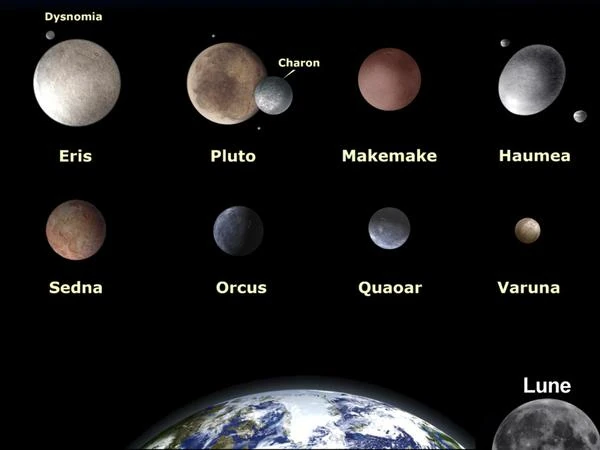
According to the International Astronomical Union (IAU), a dwarf planet is a celestial body that meets the following conditions: it orbits around the Sun, has sufficient mass for its gravity to overcome rigid body forces, giving it an almost spherical shape (hydrostatic equilibrium), has not cleared its orbit of other debris, and is not a satellite of another planet.
Dwarf planets occupy a unique place in the hierarchy of celestial bodies. Defined by the International Astronomical Union in 2006, they orbit the Sun, have sufficient mass to have a spherical shape, but have not "cleared" their orbit. This intermediate status between major planets and small bodies makes their classification sometimes contested, as in the emblematic case of Pluto.
Most dwarf planets reside in the Kuiper Belt or beyond (like Eris), but some, like Ceres, are found in the asteroid belt between Mars and Jupiter. They play an essential role in understanding planetary formation and the initial conditions of the solar system. Their composition, often rich in ices, silicates, and organic compounds, makes them valuable targets for space exploration.
| Name | Diameter | Average Distance from the Sun | Location | Orbit Type | Discovery Date |
|---|---|---|---|---|---|
| Pluto | 2,377 km | 5.91 billion km | Kuiper Belt | Resonant (3:2 with Neptune) | 1930 |
| Eris | 2,326 km | 10.12 billion km | Scattered Disc | SDO (eccentric & inclined orbit) | 2005 |
| Gonggong | 1,230 km | 10.67 billion km | Scattered Disc | SDO | 2007 |
| Makemake | 1,434 km | 6.85 billion km | Kuiper Belt | Cold Classical | 2005 |
| Haumea | 1,632 × 1,000 km | 6.45 billion km | Kuiper Belt | Resonant (12:7) | 2004 |
| Quaoar | 1,110 km | 6.43 billion km | Kuiper Belt | Hot Classical | 2002 |
| 2002 MS₄ | 934 km | 6.41 billion km | Kuiper Belt | Classical | 2002 |
| Ceres | 940 km | 414 million km | Asteriod Belt | Stable and circular orbit | 1801 |
| Sedna | 995 km | 13.6 billion km | Inner Oort Cloud | Detached (Detached TNO) | 2003 |
| Orcus | 910 km | 5.87 billion km | Kuiper Belt | Resonant (3:2 with Neptune) | 2004 |
| Salacia | 850 km | 6.48 billion km | Kuiper Belt | Hot Classical | 2004 |
| Varda | 740 km | 6.69 billion km | Kuiper Belt | Classical | 2003 |
| Ixion | 620 km | 5.91 billion km | Kuiper Belt | Resonant (3:2 with Neptune) | 2001 |
| Varuna | 668 km | 6.41 billion km | Kuiper Belt | Hot Classical | 2000 |
Sources: NASA – Dwarf Planets Overview, Minor Planet Center (MPC), International Astronomical Union, JPL Small-Body Database.
N.B.:
The Scattered Disc is a dynamic and unstable region of the Solar System located beyond the Kuiper Belt, containing icy bodies scattered on very eccentric and inclined orbits.
Ceres is the largest object in the asteroid belt located between Mars and Jupiter. With a diameter of about 940 km, it has sufficient mass and gravity to maintain an almost spherical shape, characteristic of hydrostatic equilibrium. This is why the International Astronomical Union (IAU) officially classified it as a dwarf planet. Its stable position in the asteroid belt and its orbit around the Sun confirm this unique status in this region of the Solar System.
The other major bodies of the asteroid belt, such as Vesta, Pallas, or Hygiea, although relatively large, do not yet fully meet the criteria defining a dwarf planet. Their size is smaller and their shape less spherical than that of Ceres, indicating incomplete gravitational equilibrium. Furthermore, these bodies have not yet been officially reclassified by the IAU. Recent advances from space missions, notably the Dawn probe, however, provide precise data that could lead to a future revision of this classification.